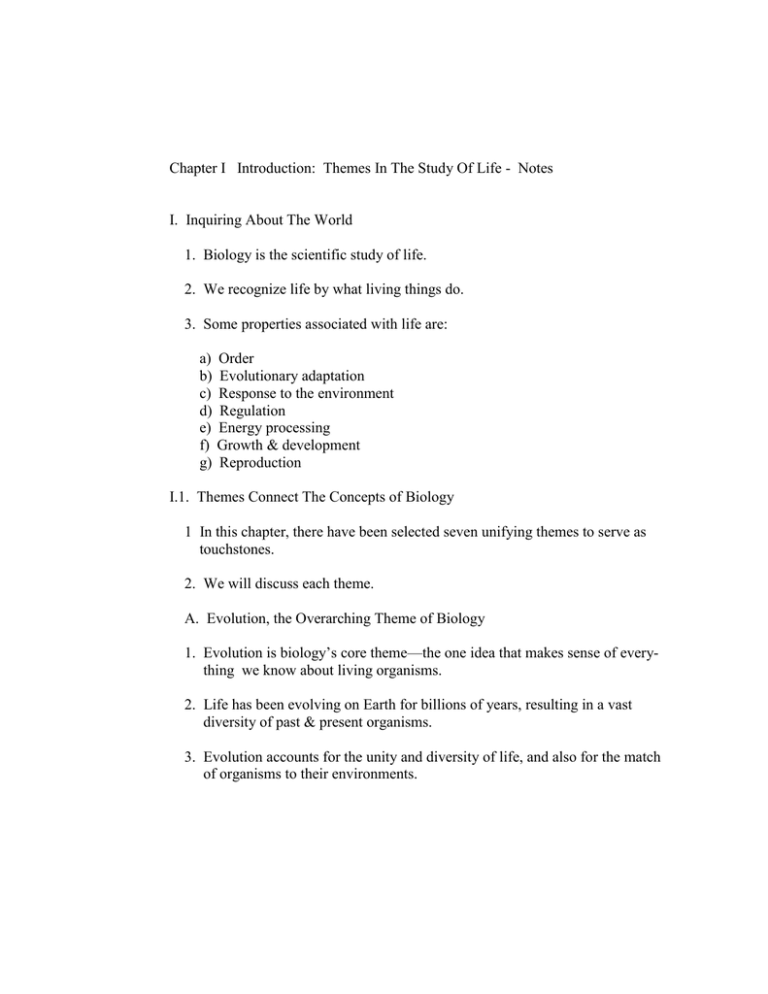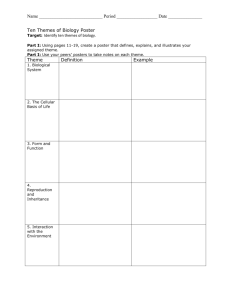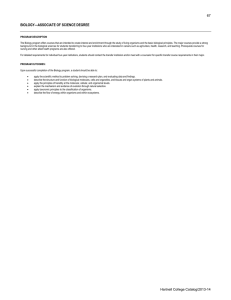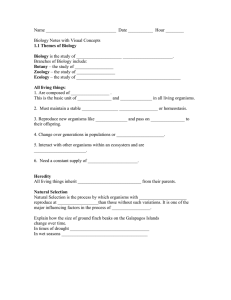Chapter I.doc
advertisement

Chapter I Introduction: Themes In The Study Of Life - Notes I. Inquiring About The World 1. Biology is the scientific study of life. 2. We recognize life by what living things do. 3. Some properties associated with life are: a) b) c) d) e) f) g) Order Evolutionary adaptation Response to the environment Regulation Energy processing Growth & development Reproduction I.1. Themes Connect The Concepts of Biology 1 In this chapter, there have been selected seven unifying themes to serve as touchstones. 2. We will discuss each theme. A. Evolution, the Overarching Theme of Biology 1. Evolution is biology’s core theme—the one idea that makes sense of everything we know about living organisms. 2. Life has been evolving on Earth for billions of years, resulting in a vast diversity of past & present organisms. 3. Evolution accounts for the unity and diversity of life, and also for the match of organisms to their environments. B. Theme: New Properties Emerge At Each Level In the Biological Hierarchy 1. With each step upward from atoms, new properties emerge as a result of Interactions among components at the lower levels: For Example – starting at the lowest level - atom>molecule>subcellular organelle>cell> tissue>organ>organ system>organism. Levels above the organisms are - species>population>community>ecosystem>biosphere. 2. Emergent properties are due to the arrangement and interaction of parts as complexity increases. C. The Power and Limitations of Reductionism 1. Because the properties of life emerge from complex organization, scientists seeking to understand biological systems, confront a dilemma. 2. Disrupting a living system interferes with its functioning. 3. In an approach called reductionism, complex systems are broken down to simpler component that are more manageable to study. D. Systems Biology 1. The goal of systems biology is to construct models for the dynamic behavior of whole biological systems. Example- Drug for blood pressure. The affects. 2. Systems biology is relevant to the study of life at all levels. E. Theme: Organisms Interact With Their Environments, Exchanging Matter & Energy 1. An organisms’s environment includes biotic as well as abiotic factors. F. Ecosystem Dynamics 1. Chemical nutrients recycle within an ecosystem. Example: Mineral acquired by trees are returned to the soil. G. Energy Conversion 1. The exchange of energy between an organism and its surroundings often involves the transformation of one form of energy to another. 2. Energy flows through an ecosystem. H. Theme: Structure & Function Are Correlated at all Levels of Biological Organization 1. Form fits function. 2. The form of a biological structure suits its function & the structure infers what the function is. I. Theme: Cells Are an Organisms’s Basic Units Of Structure & Function 1. The cell is the lowest level of organization that can perform all activities required for life. 2. Cells are categorized into two groups: either prokaryotic or eukaryotic. a) Eukaryotic cells contain membrane-enclosed organelles, the DNAcontaining nucleus is enclosed in a membrane. b) Prokaryotic cells lack membrane bound organelles, the nucleoid region is not separated from the cytoplasm. J. Theme: The Continuity of Life is Based On Heritable Information in the Form of DNA 1. The chromosomes have almost all of the cell’s genetic material, its DNA (deoxyribonucleic acid). 2. DNA is the substance of genes, the units of inheritance that transmit information from parents to offspring. K. DNA Structure & Function 1. Genetic information is encoded in the nucleotide sequences of DNA. 2. A nucleotide is composed of – a sugar (deoxyribose), a phosphate & a nitrogenous base (adenine-A, thymine – T, cytosine – C, & guanine – G) 3. DNA is a double helix (a twisted ladder) 4. DNA is capable of self-replication. 5. DNA sequences program a cell’s protein production by being transcribed into RNA & then translated into specific proteins. 6. Some RNA play other roles in the cell. 7. The entire “library” of genetic instructions that an organisms inherits is called its genome. L. Theme: Feedback Mechanisms Regulate Biological Systems 1. In negative feedback (the most common type of feedback) , accumulation of an end product slows the process that makes that product. 2. In positive feedback, the end product stimulates the production of more product. II. The Core Theme: Evolution Accounts for the Unity & Diversity of Life A. Organizing the Diversity of Life 1. Biologists classify species according to a system of broader and broader groups. 2. Domain Bacteria and Domain Archaea consist of prokaryotes 3. Domain Eukarya consist of eukaryotes. This includes various kingdomsProtists, Plantae, Fungi & Animalia. 4. As diverse as life is, it also displays remarkable unity. a) A universal genetic code b) Similarities of cell structure. B. Charles Darwin & the Theory of Natural Selection 1. Darwin proposed natural selection as the mechanism for evolutionary adaptation of populations to their environments. C. The Tree of Life 1. Each species is one twig of a branching tree of life extending bac in time through ancestral species more and more remote. 2. All of life is connected through its long evolutionary history. Example: Skeleton architecture of the bat’s wing and other mammals. III. Scientists Use Two Main Forms of Inquiry in Their Study of Nature 1. Biologists use two main types of scientific inquiry. a) Discovery science – is mostly about describing nature. b) Hypothesis-based science – is mostly about explaining nature. 2. Discovery science, scientists observe and describe some aspect of the world and use inductive reasoning to draw general conclusion. A. Hypothesis-Based Science 1. Hypothesis-based science -based on observations, scientists proposed hypotheses that lead to predictions and then test the hypotheses by seeing if the predictions come true. 2. Deductive reasoning is used in testing hypotheses. The if…then… logic is used. 3. Hypotheses must be testable & falsifiable.






